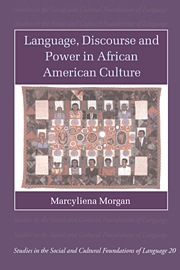Book contents
- Frontmatter
- Contents
- List of maps, figures and tables
- Acknowledgments
- Notes on the transcriptions
- Introduction
- 1 The African American speech community: culture, language ideology and social face
- 2 Forms of speech: verbal styles, discourse and interaction
- 3 Language norms and practices
- 4 When women speak: how and why we enter
- 5 Urban youth language: black by popular demand
- 6 Language, discourse and power: outing schools
- Notes
- References
- Index
- Studies in the Social and Cultural Foundations of Language
- References
References
Published online by Cambridge University Press: 17 November 2009
- Frontmatter
- Contents
- List of maps, figures and tables
- Acknowledgments
- Notes on the transcriptions
- Introduction
- 1 The African American speech community: culture, language ideology and social face
- 2 Forms of speech: verbal styles, discourse and interaction
- 3 Language norms and practices
- 4 When women speak: how and why we enter
- 5 Urban youth language: black by popular demand
- 6 Language, discourse and power: outing schools
- Notes
- References
- Index
- Studies in the Social and Cultural Foundations of Language
- References
Summary

- Type
- Chapter
- Information
- Language, Discourse and Power in African American Culture , pp. 164 - 180Publisher: Cambridge University PressPrint publication year: 2002

